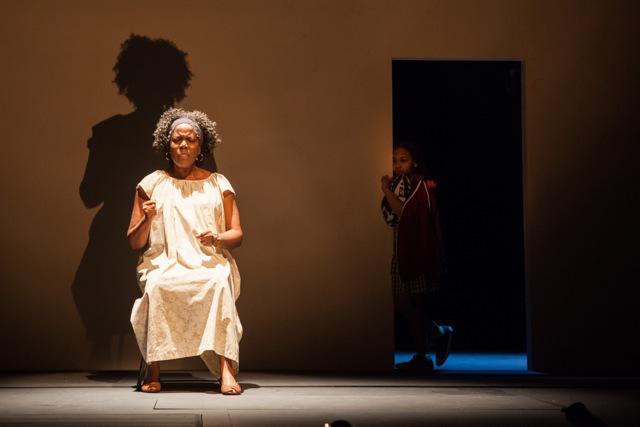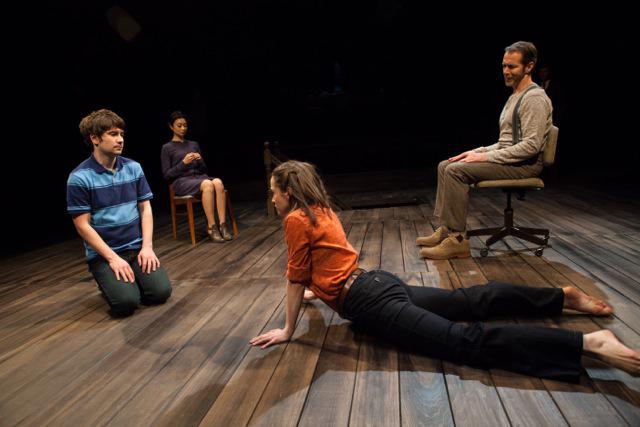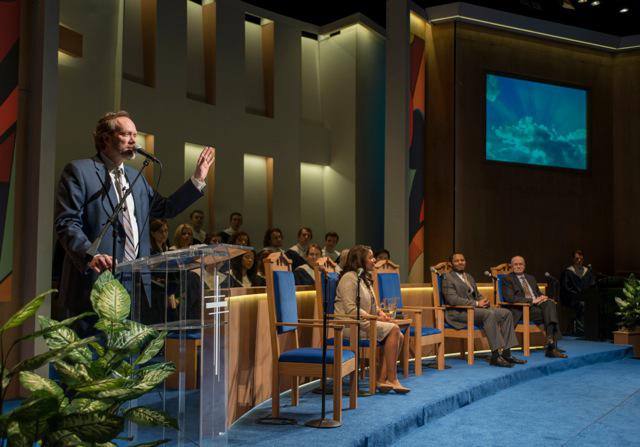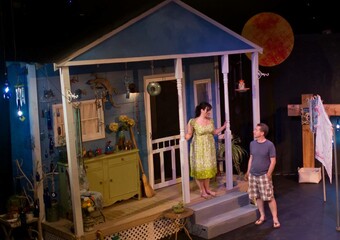Making a Statement about Diversity at the Humana Festival of New American Plays
The Humana Festival of New American Plays at the Actors Theatre of Louisville is the highest profile new play festival in the United States. Actors Theatre goes out of their way to program a diverse array of plays, representing a wide variety of voices coming from different subject positions, and putting forth divergent styles. This is my sixth Humana Festival and this year I saw five of the festival’s seven productions. The festival is not curated with an intentional theme, but all of the pieces I saw this year dealt with memory or legacy in a substantial way and I found myself thinking about the legacy of this festival. Thirty-eight years in, Actors Theatre has produced over 400 new plays by 200 authors including three plays that have gone on to win Pulitzer Prizes. Their annual published collections get contemporary plays into print where readers can access them. Artistic leaders from across the country flock to Louisville for the festival’s “Industry” weekends in search of both plays to produce, networking opportunities, and the fun of three concentrated days of theater-going.
The festival is not curated with an intentional theme, but all of the pieces I saw this year dealt with memory or legacy in a substantial way and I found myself thinking about the legacy of this festival.
Literary Director Amy Wegener articulates, “diversity happens where you’re intentional about it,” and that intentionality is apparent in both the selection of plays and the ways in which they are cast in this year’s festival (which I will discuss in more detail later in this piece).

In Kimber Lee’s brownsville song (b-side For Tray), time folds in on itself, collapsing present mourning into memories of the life of Tray (John Clarence), an eighteen-year-old grandson, brother, amateur boxer, and college bound African American man shot and killed in the working class neighborhood of Brownsville, Brooklyn. Lee takes a brief blog post about a young amateur boxer shot and killed for being in the wrong place at the wrong time as a point of departure, fleshing the rich details of characters and relationships from her own imagination. The story is political and important—stories of young black men killed in certain poor neighborhoods receive little to no public attention. Those deaths are treated by the mainstream media as if they are “normal.” In the riveting opening moment of the play, Tray’s grandmother Lena (Cherene Snow) cries out against this. “Do not begin with me,” she orders the audience. “Begin with Tray. Know Tray. Celebrate Tray.”
The play takes simple moments in ordinary life—walking a sibling home from school, asking for help with an essay, applying for a job at Starbucks, and mines them for meaning. Under the direction of Meredith McDonough, the production renders these moments with nuanced attention to detail. Lena nags Tray to finish his college scholarship applications as his younger sister Devine (Sally Diallo) eavesdrops from the shadows; in a flash he is gone and all that remains is his empty bedroom. Lena curls up on his bed, left with no way to connect but to cuddle Tray’s Jets souvenir football pillow. Devine climbs into her grandmother’s arms and the two of them curl their bodies around the Jets pillow Tray left behind.
Devine rarely speaks; her mourning is made manifest in her refusal to take off the red hoody Tray left behind. She rehearses for her dance concert with little joy until she is joined by Tray; his presence infuses her with passion and fun. Their relationship is rendered mostly in moments in expansive theatricality as they dance and play together.
I’d never heard of Kimber Lee before this year’s Humana Festival. Now I want to read everything she has ever written.
Remix 38 by Jackie Sibblies Dury, Idris Goodwin, Basil Kreimendahl, Justin Kuritzkes and Amelia Roper takes points of inspiration from iconic elements of past Humana Festival productions. It is an original work written for the nineteen actors in the Actors Theatre of Louisville’s Apprentice Company. “Remember every play you’ve ever seen” the play begins, as the ensemble stands on the steps of the Bingham theater. The packed opening night audience is invited to meditate on the empty space of the glowing white stage, to think about the lasting resonances informing this moment of anticipation. Program notes indicate the play is inspired by Crimes of the Heart (1979), Talking With… (1982), Marisol (1992), Polaroid Stories (1997), The Trestle at Pope Lick Creek (1998), Big Love (2000), Ameriville (2009), and The Method Gun (2010)—“iconic” plays originating at the Humana Festival that continue to inform audience members’ horizon of expectation of festival productions.
I’ll admit, I perhaps got too caught up looking for references to these familiar works—these plays may have provided points of departure for the playwrights but as an audience member I recognized very few elements from them in the piece itself. If the piece were not titled Remix and framed in relation to past productions, I may have seen it more clearly for what it is—a series of unrelated ten minute plays written by emerging and early/mid career playwrights and showcasing talented young actors.

Photo by Bill Brymer.
In The Grown-Up by Jordan Harrison, directed by Ken Rus Schmoll, time goes by fast. Kai (Matthew Stadelmann) sits at his grandfather’s (Paul Niebanck) knee, enraptured by stories of a magic doorknob that can open doors to other worlds. When Kai goes through the door, it catapults him forward in time into his own future. One minute, he is ten. The next, he is twenty-seven. Then almost forty. Children cannot wait to grow up, but once grown, the boy just wants to go back home, to hang on to fleeting moments of joy and beauty, and to understand the meaning of a life flying by. An ensemble including Niebanck, Brooke Bloom, Tiffany Villarin, Chris Murray, and David Ryan Smith at times narrate the story and at others slip in and out of role as the people populating his life. The story slips and slides through time, turning back on itself to reveal the mythic origins of the magic doorknob, spinning new tales out of the struggles of secondary characters, using simple dramatic conventions to evoke a magical world.

In The Christians by Lucas Hnath and directed by Les Waters, audience members are framed as congregants in the Pamela Brown Theatre, which is transformed by scenic designer Dane Laffrey’s set into the chapel of a contemporary megachurch. Pastor Paul (Andrew Garman) has had a crisis of faith, and in a public sermon unilaterally changes the church’s stance on the necessity of belief in the divinity of Jesus for individual salvation. This major shift in doctrine sends waves through the congregation and Pastor Paul’s family. The Christians fully articulates two opposing religious perspectives—one rooted in secular humanism and one in a more traditional evangelical Christianity—and gets audience members to understand both perspectives. It takes believers seriously and represents the love fueling the religious arguments at the core of the play.
The production is interactive, as audience members are encouraged to clap or pray along throughout the participatory theatrical event. The actors speak into microphones throughout the entire play, highlighting the public nature of their roles as pastor, wife (Linda Powell), associate pastor (Larry Powell), elder (Richard Henzel), and congregant (Emily Donahoe). Even conversations in the pastor’s bedroom are spoken into microphones, underscoring the ways in which their private relationships with each other and with God are made public by these roles.
SITI Company’s Steel Hammer is directed by Anne Bogart and written by Kia Corthron, Will Power, Carl Hancock Rux, and Regina Taylor with music and lyrics by Julia Wolfe and recorded music by Bang On A Can All-Stars and Trio Mediaeval. Using a combination of movement, music, and dance in a style that is familiar to audience members who watch SITI Company’s work, Steel Hammer deconstructs the myth of John Henry, a working class American hero and a railroad worker who out-hammered a steam engine and died from the exertion.
The play historicizes and complicates this folktale, highlighting the many variations on the story (Was he 6’5”? Was he 5’1? Was his wife Polly Ann? Was his wife Lucy?). The production takes a critical look at the legacy of racism in the United States. Early on, it highlights a version of the story in which John Henry a black man is imprisoned for vagrancy or on trumped up charges in the reconstruction-era south—a man trapped by laws that make it illegal to be a black man looking for work—and forced to work hard labor as part of his imprisonment. The piece repeatedly made me think about the historic roots of the contemporary problem that one in three black men in the United States is likely to be incarcerated during his lifetime. Steel Hammer—like all SITI Company work—is open-ended, full of complexity, and asks audience members to work to make their own meaning from it.
Across the festival, every production I saw had a multiracial cast; brownsville song and Steel Hammer deal explicitly with race and cast accordingly, and all the others include actors of color in roles that did not require racially-specific casting. As a result, the festival includes multiple representations of interracial couples and multiracial families, all treated as unremarkable and “normal.” “That’s what the world looks like,” artistic director Les Waters explains. I could not agree more. The practice of multiracial casting is neither new nor exclusive to Actors Theatre, but I find it particularly important to highlight because of the visibility of the Humana Festival in the regional theater community. Waters tells me that fifty percent of the performers in the festival this year are performers of color.
This runs against the grain of assumptions some people may have about audiences in the south or the middle of the country or small to mid-sized cities—that audiences in Brooklyn or San Francisco may be friendly to representations of a multiracial society, but those in smaller cities in “red” states are not. As Waters puts it, “audiences are smart” and the Actors’ Theatre of Louisville has built a local audience base—in this particular small city in Kentucky—that wants to engage with challenging work in a sophisticated way.








Comments
The article is just the start of the conversation—we want to know what you think about this subject, too! HowlRound is a space for knowledge-sharing, and we welcome spirited, thoughtful, and on-topic dialogue. Find our full comments policy here
A lovely ode to Humana - but there is no mention of the lack of diversity behind the table (directors, playwrights, and designers of color, beyond the B&W spectrum). Until those opportunities are opened in those positions, the title of this article misleads the reader in believing that ATL is fully inclusive, when in Humana's history, there has never been a Latina/o director nor plays detailing the Latina/o and Native American experience represented (beyond 10-minute works fr. writers) at the festival.
Thanks, Tlaloc. That's an important point.
Thanks so much, Dani, for your thoughtful
article. I appreciate Tlaloc’s urging to look further at the mix of voices, but
I do want to correct a factual misperception when he says that full-length work
directed by or written from the experience of Latino/a artists has “never” been
produced in the Humana Festival. This is
not true. Actors Theatre has produced new full-length plays by writers such as
Eduardo Machado, Jose Rivera, Guillermo Reyes, and Carlos Murillo in the Humana
Festival. Directors who’ve worked in the festival include Michael John Garces (who
has also participated as a playwright) and KJ Sanchez. While the comment makes a distinction about
play length, it’s worth noting that other Humana contributors in recent years
have included Tanya Saracho, Kristoffer Diaz, and Marco Ramirez. Full-length work by Diaz, KJ Sanchez (as both
a writer and director), and Matthew Lopez has been produced outside of Humana
too, as part of our recent mainstage subscription seasons. To say that there is no diversity “behind the
table” beyond the “B&W spectrum” also leaves out of the conversation the
Humana Festival’s inclusion of work by artists like Kimber Lee, A. Rey
Pamatmat, May Adrales, Michael Golamco, and Mona Mansour.
Dear Ms. Wegner,
Thank you for your clarification on the history of Humana. My point was directly about the misperception the title and the claims the article makes about true diversity. With the exception of the short plays and collectively-written works (Universes) - which you humbly pointed out - Humana has not selected nor produced a premiere of a full-length play written by Latina/o since 2007's Dark Play or Stories for Boys by Carlos Murillo, nor a Latina/o director since Michael John Garces directed When The Sea Drowns in the Sand in 2001. Those are long stretches of time for a company devoted to new 'American' drama - given the quickly changing demographics of our society and the explosion of new writing and new work that is emerging from the experience of 'Latinidad'. So forgive me for expressing my desire to see more inclusion in the theater across the cultural spectrum - it is what I have to do in order to feel that I have place at the table in the American theater so that I can continue inspire and mentor those who want to believe the same - and who want to work with your company in the future. Through the Latina/o Theatre Commons, perhaps I can invite you and your artistic staff to our National Encuentro in Los Angeles (October 2014) and our National Carnival of New Plays in Chicago (Summer 2015) so that you - and the rest of the country - can experience the rich diversity of our culture and aesthetic. Nuestra casa es su casa ...
Tlaloc Rivas
Writer/Director/Theatre-Maker
Latina/o Theatre Commons
Assistant Professor of Theatre, The University of Iowa